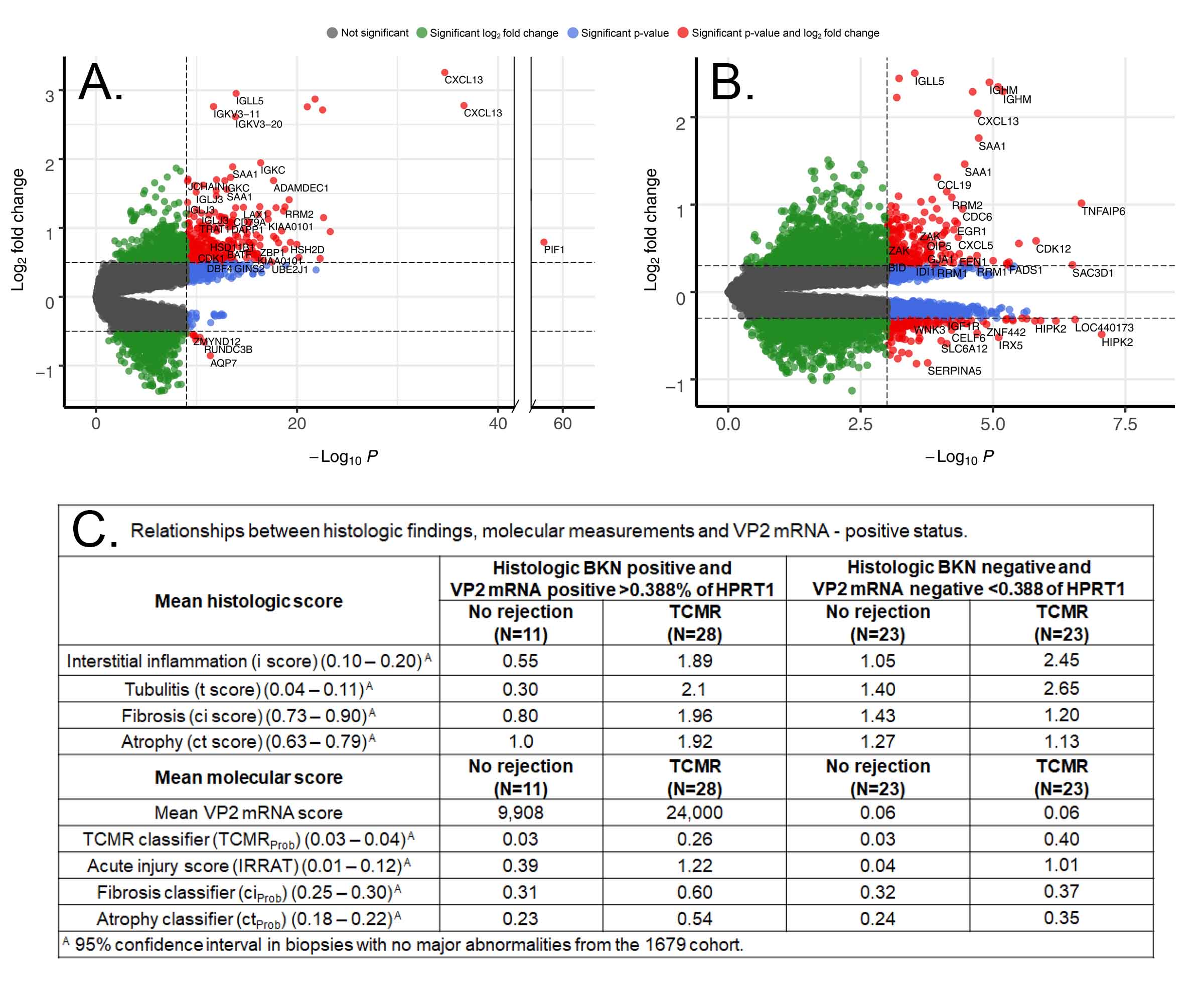VP2 MRNA Distinguishes the Direct Injury and Inflammation Effects of Polyoma Virus (BK) Infection from the Cognate TCMR Response That Follows Immunosuppressive Minimization
1Alberta Transplant Applied Genomics Centre, Edmonton, AB, Canada, 2Medical University of Vienna, Vienna, Austria, 3Virginia Commonwealth University, Richmond, VA, 4Pomeranian Medical University, Szczecin, Poland, 5Institute for Clinical and Experimental Medicine, Prague, Czech Republic, 6., Edmonton, AB, Canada
Meeting: 2021 American Transplant Congress
Abstract number: 265
Keywords: Gene expression, Kidney, Polyma virus, Rejection
Topic: Clinical Science » Infectious Disease » Kidney: Polyoma
Session Information
Session Name: BK virus in Kidney Recipients
Session Type: Rapid Fire Oral Abstract
Date: Monday, June 7, 2021
Session Time: 6:00pm-7:00pm
 Presentation Time: 6:00pm-6:05pm
Presentation Time: 6:00pm-6:05pm
Location: Virtual
*Purpose: BK virus nephropathy (BKN) and T cell-mediated rejection (TCMR) are difficult to distinguish by histology but often coexist due to the necessity for immunosuppression minimization. We sought to use molecular changes to distinguish direct virus damage from cognate T cell activity.
*Methods: We used microarrays to study molecular changes associated with histologically defined BKN in kidney transplant biopsies in the INTERCOMEX study. Molecular classifiers estimated parenchymal injury, inflammation, and TCMR in 1679 biopsies (55 with BKN). In a subset of 102 biopsies (50 BKN/52 no BKN, 26 TCMR/26 other abnormalities), we measured expression of BK capsid protein VP2 mRNA by RT-PCR to quantify viral activity.
*Results: Top transcripts associated with BKN (Fig. 1A) reflected inflammation (e.g. CXCL13) and atrophy-fibrosis (e.g. IGKC immunoglobulin gene). Gene Ontology (GO) analysis revealed terms related to DNA replication.
VP2 mRNA identified BKN with AUC=0.94. VP2 expression was positive in 45/50 histologic BKN biopsies and negative in 46/52 control biopsies. GO analysis of VP2-associated transcripts (Fig. 1B) represented injury, atrophy-fibrosis, inflammation, with terms associated with mitosis and DNA repair, many shared with the BKN analysis in Fig. 1A.
Transcripts correlating with VP2 activity correlated with the BKN classifier but not the TCMR classifier, distinguishing BKN from TCMR (Fig. 1C). BKN/VP2 mRNA positive biopsies with molecular TCMR had severe tubulitis compared to BKN/VP2 positive biopsies with no TCMR, plus increased injury and atrophy-fibrosis (Fig. 1C). In 5 sets of serial biopsies, molecular TCMR scores increased as VP2 decreased, indicating distinct dynamics for direct virus injury vs. cognate T cell activity.
*Conclusions: VP2 mRNA expression in BKN parallels virus-induced parenchymal injury and innate immunity, while molecular TCMR develops independently as an adaptive immune response. Heavy tubulitis in BKN indicates emergence of TCMR. Whether BK-specific adaptive immunity produces a molecular TCMR phenotype without alloimmunity requires further study. VP2 mRNA measurement could guide clinical management when BKN and TCMR coexist.
To cite this abstract in AMA style:
Halloran PF, Famulski K, Madill-Thomsen KS, Böhmig G, Gupta G, Myślak M, Viklicky O. VP2 MRNA Distinguishes the Direct Injury and Inflammation Effects of Polyoma Virus (BK) Infection from the Cognate TCMR Response That Follows Immunosuppressive Minimization [abstract]. Am J Transplant. 2021; 21 (suppl 3). https://atcmeetingabstracts.com/abstract/vp2-mrna-distinguishes-the-direct-injury-and-inflammation-effects-of-polyoma-virus-bk-infection-from-the-cognate-tcmr-response-that-follows-immunosuppressive-minimization/. Accessed December 20, 2025.« Back to 2021 American Transplant Congress

